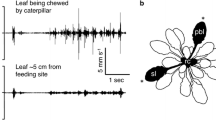Summary
-
1.
Drosophila melanogaster males produce courtship songs consisting of tone bursts of 160 Hz (sine song) and pulse trains of 3 ms single cycle pulses at interpulse intervals (ipis) of 34 ms (pulse song). The sounds are produced by small amplitude vibrations of one extended wing. The role of the indirect flight muscles was investigated by implanting electrodes into the muscle units and recording the electrical activity during courtship song.
-
2.
During flight the pattern of firing of the motor units is influenced by two factors: by common excitation of all the units which causes their average rate of firing to fluctuate synchronously and by reciprocal inhibition between the units within some of the muscles which results in phase stable patterns of firing (e.g. Figs. 5, 8). There is evidence of reciprocal inhibition occurring during sine song and pulse song also. However in the latter the phase pattern is influenced to a considerable extent by the timing of individual sound pulses. The simplest case is where two motor units fire during the same ipi (Fig. 10c) or on alternate ipis (Fig. 10b) giving a bimodal phase distribution with peaks at phases of 0.5 and 1.0 (Fig. 7).
-
3.
It can be shown that the muscle potentials are related to the subsequent and not the preceding sound pulses (Table 2). The units within one of the muscles, DVM I, have two modes of firing; either in synchrony with the other muscle units or with a delay of 20–25 ms (Fig. 13).
-
4.
It is suggested that the timing of the muscle potentials in the indirect flight muscles during pulse song is due to shared excitation with an unidentified muscle, the pulse timer muscle (PTM). As contraction of the indirect muscles is initiated not by motor action potentials but by being stretched, some muscle (the PTM) which subserves this function is a necessity. The similarity between the system proposed for pulse song and for flight starting is noted.
-
5.
During sine song the indirect flight muscles are stimulated at a much lower frequency than during either flight or pulse song (Table 1) and some units remain totally inactive. This will result in little power being produced by the muscles and account for the low frequency, low amplitude sine song.
Similar content being viewed by others
References
Bentley, D.R.: Intracellular activity in cricket neurons during generation of song patterns. Z. vergl. Physiol.62, 267–283 (1969)
Bennet-Clark, H.C., Ewing, A.W.: Stimuli provided by courtship of maleDrosophila melanogaster. Nature (Lond.)215, 669–671 (1967)
Bennet-Clark, H.C., Ewing, A.W.: The wing mechanism involved in the courtship ofDrosophila. J. Exp. Biol.49, 117–128 (1968)
Bennet-Clark, H.C., Ewing, A.W.: Pulse interval as a critical parameter in the courtship song ofDrosophila melanogaster. Anim. Behav.17, 755–759 (1969)
Ewing, A.W.: The evolution of courtship songs inDrosophila. Rev. Comp. Animal4, 3–8 (1970)
Ewing, A.W., Bennet-Clark, H.C.: The courtship songs ofDrosophila. Behaviour31, 288–301 (1968)
Heide, G.: Die Funktion der nicht-fibrillären Flugmuskeln vonCalliphora. II. Muskuläre Mechanismen der Flugsteuerung und ihre nervöse Kontrolle. Zool. Jb. Physiol.76, 99–137 (1971)
Huber, F.: Neuronal background of species-specific acoustical communication in orthopteran insects (Gryllidae). In: The Biology of brains, pp. 61–88 (ed. W.B. Broughton). London: Institute of Biology 1974
Levine, J.: Properties of the nervous system controlling flight inDrosophila melanogaster. J. comp. Physiol.84, 129–166 (1973)
Levine, J.D., Hughes, M.: Stereotactic map of the muscle fibres in the indirect flight muscles ofDrosophila melanogaster. J. Morph.140, 153–158 (1973)
Machin, K.E., Pringle, J.W.S.: The physiology of insect fibrillar muscle: II. Mechanical properties of a beetle flight muscle. Proc. Roy. Soc. Lond. B.151, 204–225 (1959)
Mulloney, B.: Organisation of flight motoneurons of diptera. J. Neurophysiol.33, 86–95 (1970)
Nachtigall, W., Wilson, D.M.: Neuro-muscular control of dipteran flight. J. Exp. Biol.47, 77–97 (1967)
Pringle, J.W.S.: Locomotion: Flight. In: The Physiology of insecta, 2nd Edition, Vol. III (ed. M. Rockstein), pp. 433–476. Academic Press 1974
Schilcher, F. von: The role of auditory stimuli in the courtship ofDrosophila melanogaster. Anim. Behav.24, 18–26 (1976a)
Schilcher, F. von: The behaviour ofcacophony, a courtship song mutant inDrosophila melanogaster. Behav. Biol.17, 178–196 (1976b)
Wyman, R.: Lateral inhibition in motor output system. I. Reciprocal inhibition in dipteran flight motor system. J. Neurophysiol.32, 297–306 (1969)
Wyman, R.J.: Neural circuits patterning dipteran flight motoneuron output. In: Neurobiology of Invertebrates (ed. J. Salanki), pp. 289–309. Budapest, Hungarian: Academy of Sciences 1973
Wyman, R.J.: A simple network for the study of neurogenetics. In: Simpler networks and behaviour (ed. J.C. Fentress), pp. 153–166. Massachusetts: Sinauer Associates Inc. 1976
Author information
Authors and Affiliations
Additional information
I should like to thank the following for their helpful and constructive criticisms of this paper and of an earlier draft: Dr. H.C. Bennet-Clark, Mr. M. Dow, Dr. L.S. Ewing, Prof. Dr. F. Huber, Prof. A. Manning, Dr. L. Partridge and Prof. J.W.S. Pringle.
Rights and permissions
About this article
Cite this article
Ewing, A.W. The neuromuscular basis of courtship song inDrosophila: The role of the indirect flight muscles. J. Comp. Physiol. 119, 249–265 (1977). https://doi.org/10.1007/BF00656637
Received:
Issue Date:
DOI: https://doi.org/10.1007/BF00656637




